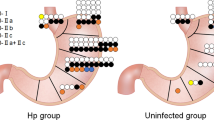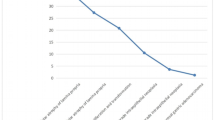Summary
The thickness of Brunner’s glands was measured using an ocular micrometer in 297 cases of surgically resected peptic ulcer and in 120 autopsy cases (control group). The mean maximum thickness of Brunner’s glands in the control group was 1.55±0.37mm (mean±SD) and no difference in thickness was noted for each decade of age. The mean maximum thickness of Brunner’s glands in patients with gastric ulcer, duodenal ulcer and gastroduodenal ulcer was 2.34±1.06, 3.18±1.07 and 3.24±1.05mm, respectively. When an ulcer is within the duodenum, Brunner’s glands near the ulcer were thicker than those contralateral to it. In patients with gastric ulcer, Brunner’s glands were the thickest in the pyloric ulcer group and negative correlation was noted between the thickness of Brunner’s glands and the distance to the ulcer from the pyloric ring. Since gastric acidity is supposed to be lower when an ulcer is located more proximally, these results suggest that Brunner’s glands become hyperplastic not only with the presence of an ulcer in the duodenum but also by acid hypersecretion of the stomach.
Similar content being viewed by others
References
Florey HW, Harding HE: Further observations on the secretion of Brunner’s glands. J Pathol Bacteriol 1934;39:255–276
Florey HW, Jennings MA, Jennings DA, et al: The reactions of the intestine of the pig to gastric juice. J Pathol Bacteriol 1939;49:105–123
Griffith CA, Harkins HN: The role of Brunner’s glands in the intrinsic resistance of the duodenum to acid-peptic digestion. Ann Surg 1956;143:160–172
Tsuchihashi Y, Fuse Y, Sugihara H, et al: Color image analysis of mucin content of Brunner’s glands in cysteamine-induced duodenal ulceration. In: Kawai K, ed. Gastric Mucus and Mucus Secreting Cells. Excerpta Medica, Tokyo. 1985;19–28
Fuse Y, Tsuchihashi Y, Fujita S, et al: Thickness of Brunner’s glands and its clinical significance in duodenal ulcer cases. Igakunoayumi 1987;140:915–917 (in Jpn)
Robertson HE: The pathology of Brunner’s glands. Arch Pathol 1941;31:112–130
Florey HW, Harding HE:The healing of artificial defects of the duodenal mucosa. J Pathol Bacteriol 1935;40:211–218
Fuse Y, Tsuchihashi Y, Sugihara H, et al: Autoradiographic study on healing process of cysteamine-induced duodenal ulcer in rat. Possible importance of Brunner’s glands in ulcer healing. Dig Dis Sci 1988;33:1081–1088
Westphal G, Grossman MI: Introduction to the problem of peptic ulcer. Healing of acute and chronic ulcers. In: Ivy AC, Grossman MI, Bachrach WH, eds. Peptic ulcer. Blakiston, Philadelphia. 1950;150
Poulsen SS, Olsen PS, Kirkegaard P: Healing of cystemineinduced duodenal ulcer in rats. Dig Dis Sci 1985;30:161–167
Wormsley KG, Grossman MI: Maximal histalog test in control subjects and patients with peptic ulcer. Gut 1965;6:427–435
Tatsuta M, Okuda S: Location, healing, and recurrence of gastric ulcers in relation to fundal gastritis. Gastroenterology 1975;69:897–902
Card WI, Marks IN: The relationship between the acid output of the stomach following “maximal” histamine stimulation and the parietal cell mass. Clin Sci 1960;19:147–163
Author information
Authors and Affiliations
Rights and permissions
About this article
Cite this article
Fuse, Y., Tsuchihashi, Y., Takamasu, M. et al. Thickness of Brunner’s glands and its clinical significance in peptic ulcer diseases. Gastroenterol Jpn 24, 512–518 (1989). https://doi.org/10.1007/BF02773877
Received:
Accepted:
Issue Date:
DOI: https://doi.org/10.1007/BF02773877




